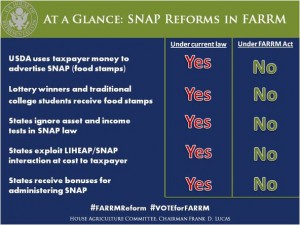I know the mere words “farm bill” are enough to put any sane person into a coma, but what’s happening in Congress can be quite entertaining if you don’t care what happens.
For example, the bill is so big and covers so much territory that just about every legislator introduces amendments (these are tracked by FarmBillPrimer.org).
Because SNAP (Supplemental Nutrition Assistance Program) takes up 80% of farm bill funding to the tune of about $80 billion a year, lots of amendments deal with further decreasing the budget allocation or restoring amounts that have been cut. So far, none of these has passed.
But legislators have other things they want SNAP to do. For example, Senator Tom Coburn MD (Rep-Oklahoma) has introduced several amendments pertaining to SNAP, among them:
Amendment 1000 – Junk Food Purchases with SNAP: Requires the Secretary of Agriculture to approve state demonstration projects that limit the purchase of junk food under the Supplemental Nutrition Assistance Program. Additional information here.
Energy drinks, candy bars, sodas, ice cream, potato chips, fancy bakery cakes and cookies are all eligible foods under the program, as defined by statute…Few people would qualify these goods as “nutritional assistance.”
Amendment 1001 – Food Stamps: Returns the title of the Supplemental Nutrition Assistance Program to its original name, the Food Stamp program. Additional information here.
Congress renamed the Food Stamp Program to the Supplemental Nutrition Assistance Program, and made a name change to the underlying legislative bill governing food stamps. Given spending patterns and eligible purchases in the program, though, SNAP is anything but nutritious for recipients or the country as a whole. Instead of misleading the public as to its benefits, SNAP should be renamed its original title, the Food Stamp Program. This name…is also a reminder of the core goal of the program: to serve our nation’s most vulnerable.
Amendment 1002 – SNAP Promotion Limitation: Limits the amount of SNAP funding that may be used to promote increased participation and enrollment in the program to 1% of overall funds and prevents SNAP funding for soap operas and parties. Additional information here.
Giveaways, soap operas, and radio miniseries all may be solid advertising opportunities for private companies wishing to market a product. They are not, however, appropriate uses of taxpayer funds to advocate for greater enrollment in SNAP, which would even further drain the government’s already-depleted coffers.
Want to take bets on whether the Senate, let alone the House, will pass any of these?



